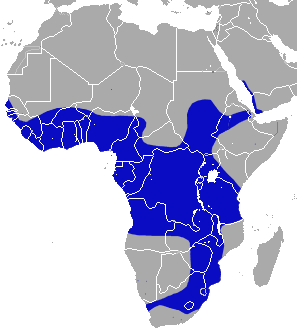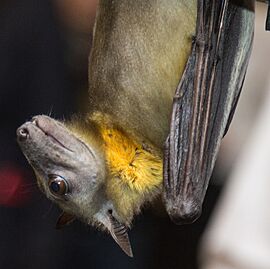Straw-coloured fruit bat facts for kids
Quick facts for kids Straw-coloured fruit bat |
|
|---|---|
 |
|
| Conservation status | |
| Scientific classification | |
| Genus: |
Eidolon
|
| Species: |
helvum
|
 |
|
| Straw-coloured fruit bat range | |
The straw-coloured fruit bat (Eidolon helvum) is a large bat that loves to eat fruit! It's the most common type of big bat found in Africa. You can find it in many places, from the southwestern Arabian Peninsula all the way across Africa, in forests and grassy areas called savannas. Sadly, its population is shrinking, so it's listed as a Near Threatened animal.
These bats live in huge groups, sometimes with over 100,000 bats, and even up to a million! Every year from October to December, something amazing happens: up to 10 million straw-coloured fruit bats gather in Kasanka National Park in Zambia. This is the biggest mammal migration on Earth! They all roost together in a small forest area. This incredible journey was only discovered in 1980. These bats have yellowish-brown fur on their necks and backs, and their undersides are a brownish color.
Contents
What Does a Straw-Coloured Fruit Bat Look Like?
The straw-coloured fruit bat gets its name from its soft, yellowish fur. Its wings are black, and the fur on its back is light and brownish-yellow. Male bats are usually bright orange, while females are more yellowish.
These bats have large cheeks, eyes, and ears. They typically weigh between 227 to 340 grams (8 to 12 ounces). They grow to be about 14 to 23 centimeters (5.7 to 9 inches) long. Their wings can spread up to 76 centimeters (30 inches) wide. Males are generally bigger than females. This bat has a very large heart, and its wings are long and pointed at the ends. Their cheeks are also large and can form pouches.
How Do These Bats Live and Behave?
The straw-coloured fruit bat is a very social animal. These bats often live in colonies of more than 100,000. Sometimes, these groups can grow to almost one million bats! At night, smaller groups of bats leave their roosting spots to find food. They use their excellent sight and smell to locate meals. They have also been seen chewing on soft wood to get moisture.
These bats are very important for forests. They help pollinate flowers, just like bees do. They also help spread seeds through the forests. This process is called seed dispersal. They are the main animals that spread the seeds of the African teak tree (Milicia excelsa). This tree is becoming rare and is very important for the economy.
Even though they eat at night, straw-coloured fruit bats are not always sleeping during the day. They can be found resting and moving around within their colony. Year after year, and season after season, these bats will return to the same places where they found food before.
Reproduction and Life Cycle
Straw-coloured fruit bats usually mate from April to June. Not all bats mate at the same time. The fertilized egg does not immediately attach to the mother's womb. This delay is called embryonic diapause. The egg finally attaches in October, and all females do this around the same time. This delay happens during one of the dry seasons where the bats live. Baby bats are then born in February and March.
What Do Straw-Coloured Fruit Bats Eat?
The diet of straw-coloured fruit bats changes depending on if they are in the wild or in a zoo. Wild bats usually eat tree bark, flowers, leaves, nectar, and fruits. In zoos, they are fed different mixes of fruits. These can include apples, oranges, bananas, grapes, and cantaloupe. Some zoos also give them a special diet made for marmosets.
Where Do Straw-Coloured Fruit Bats Live?
The straw-coloured fruit bat is the most widespread fruit bat in Africa. It might even be the most widespread in the world! It is found mostly in Africa, especially in the sub-Saharan regions. It lives in many forest and savanna areas. You can also find it around the southwestern Arabian Peninsula. These bats can even live in cities and at high places, up to 2,000 meters (6,562 feet) above sea level. They prefer to roost in tall trees.
What Threats Do Straw-Coloured Fruit Bats Face?
Straw-coloured fruit bats are hunted for their meat in West and Central Africa. This meat is sometimes called bushmeat.
In 2011, it was estimated that about 128,400 straw-coloured fruit bats were traded for meat each year in just four cities in southern Ghana. This hunting can reduce their numbers.



